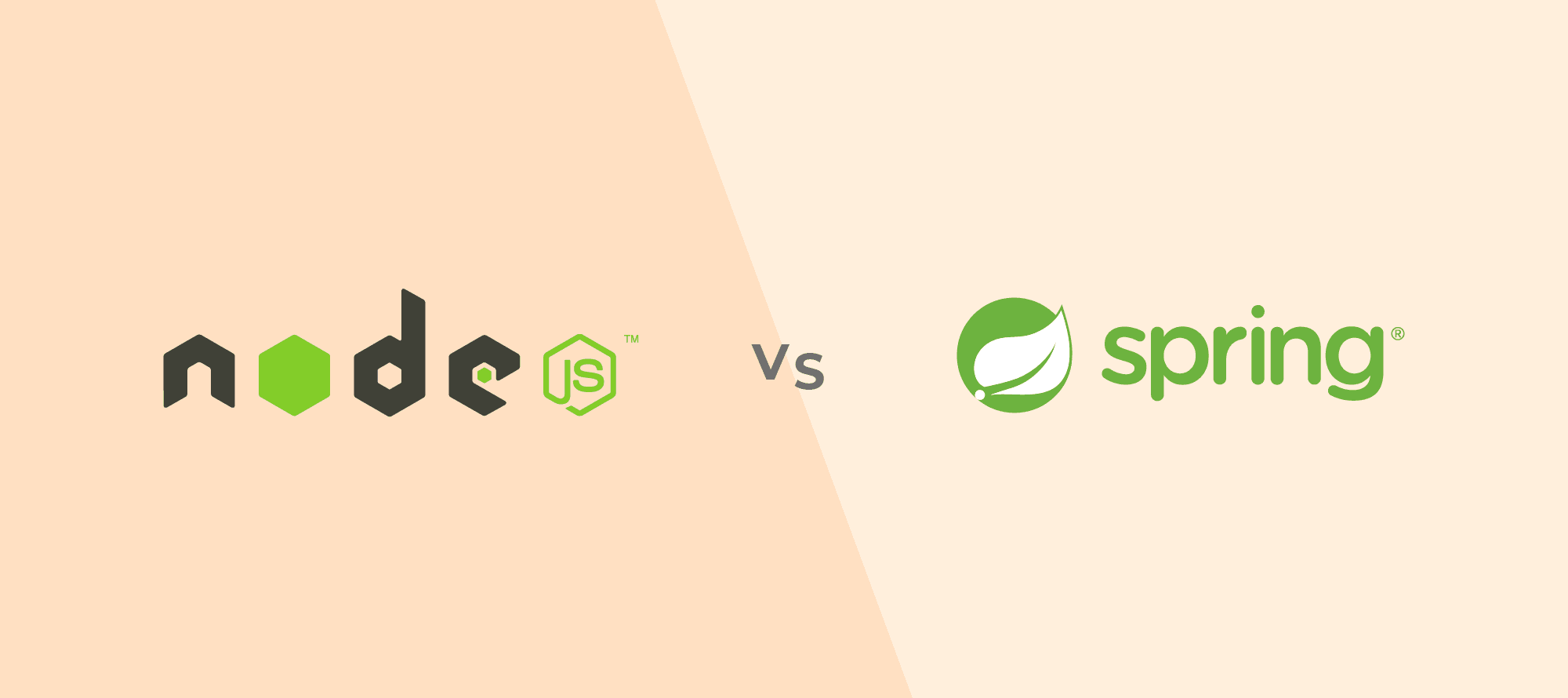
Subscribe to our Blog
We're committed to your privacy. SayOne uses the information you provide to us to contact you about our relevant content, products, and services. check out our privacy policy.

Real PradJune 8, 202110 min read

Generating table of contents...
Today, several server-side technologies power businesses in powerful ways. Examples are online marketplaces and food delivery apps, among others. Most of the work that we do today is online. Schooling and meeting doctors also take place online.
You can use several technologies to make your business available online, some of them being Node.js, Java Spring Boot, or Python. In this article, we attempt to compare Node.js and Java Spring Boot and see which one is preferable for building microservices applications. Many enterprise organizations are moving their software from monolith applications to microservices to attain higher efficiencies and significant other advantages.
Node.js and Java Spring Boot are two server-side languages that are in tough competition. Node.js is a runtime environment that is often used for executing JavaScript code outside of the web browser. Java Spring Boot can be used to build, configure, and execute web-based application programs.
Download our eBook for FREE: “Global Software Development Rates – an Overview”.
Java itself is a class-based OO programming language. Java is portable, in the sense, a java program that is written for a specific platform runs on a consolidated hardware-OS combination. Spring Boot Java is an open-source framework (Java-based) used for the creation of a microservice.
Node.js is a platform that is built on Chrome’s JavaScript runtime and is best used for building fast and scalable networking applications easily. In short, Node.js is a runtime library as well as an application that is extensively used for generating server-side JS applications. Node.js developers frequently use it for creating JavaScript applications because it is open-source, free, and can be used for cross-platform coding. The scripts can be written faster and also enables easy scalability.
Java is just a language but Node.js is an ecosystem formulated on JavaScript and is in sync with Google’s V8 engine. This is present on most OS such as Windows, macOS, Linux, and some others. The execution environment in the case of Java is the JVM or a virtual machine.
When it comes to enterprise development in Java, the two most commonly debated frameworks are Java EE vs Spring Boot. Both have their distinct features, strengths, and areas of application.
Java with its ecosystem with libraries, plugins, and APIs and a virtual machine with a runtime environment has evolved on its own.
Spring Boot which is implemented using Java allows a quick build-up of standalone applications. The bootstrapped version of the Spring platform helps to get the application running by reducing the procedures.
One is a language and the other is a runtime environment. However, it is important to understand the differences between the two, because only then can the right tools be used with these frameworks to make the business applications function better.



Spring Boot Java is multi-threaded and therefore several tasks can be completed concurrently. This helps applications to perform better. In large-scale projects involving multiple tasks that have to be completed simultaneously, Java is recommended in place of Node.js.
Node.js, on the other hand, is single-threaded, which means that one request can be dealt with using one thread. In the case of a database query, the thread does not have to wait while the data is being fetched as a response to the first query. The thread can then handle another request.
Once the database completes the task, the message reaches the event queue. Node.js monitors the queue continuously, detects the events and starts processing it. This makes Node.js perfectly suitable for I/O-based applications that call for wide network access.
However, in the case of calculations, Node.js caters to the second client only after the request of the first client is completed. Therefore, Node.js is not recommended in situations CPU-intense operations such as image manipulation or video encoding.
READ ALSO: Explore the Pros and Cons of Using Node.js for Web Development
I/O model is the process wherein data is displayed or referred to on the computer. I/O calls are either of the blocking or non-blocking types. Whereas in the blocking type, the thread does not do much unless the IO is completely received, in the non-blocking type, the thread implements other requests without waiting.
Whereas Node.js applications are both asynchronous and non-blocking, Spring Boot Java has blocking I/O. In Node.js applications, developers can send more than one request at a time, whereas with Spring Boot Java, the developer will have to wait for every single I/O request.
Web applications of an enterprise nature require a high amount of concurrency. Spring Boot Java has to dedicate one thread for each request. Therefore, many threads are required for concurrency. When the request load is high, the OS cuts the time of the CPU among these requests. This turns out to be expensive and less efficient.
However, Node.js is efficient in that the CPU has no cut of the processing time and this time is devoted to the process that is currently taking place.
Whereas Node.js is preferred for its great libraries and JavaScript factors, Spring Boot is deemed popular because of the keywords such as Java, easy setup, and powerful and handy.
For all your Spring Boot requirements, give us a call today!
If you want your application to do a large amount of computing such as in Big Data, eCommerce or IoT, then it is better to go the Spring Boot way. However, wherever applications need a lot of I/O, such as in media apps, booking systems, and finance technology apps, Node.js is a better choice.
With JavaScript being easier to learn, onboarding new members to the team is likely an easier task and this is a perfect fit when building microservices. Moreover, developers can pick up any task from the front end to the back end at any given point in time.
READ ALSO: The 5 Best Microservices Technologies List
Download Now: Development process for the layperson and what does it take to build an application
 First created by Sun Microsystems, and now owned by Oracle, Java is widely used for server-side programming for a long time now. For many companies, some issues arise when Java is used. The use of Java on Android was not without problems, which is the reason Google adopted Kotlin.
First created by Sun Microsystems, and now owned by Oracle, Java is widely used for server-side programming for a long time now. For many companies, some issues arise when Java is used. The use of Java on Android was not without problems, which is the reason Google adopted Kotlin.
Google has not completely disowned Java. It uses the JVM in Dalvik, an Android core. The Android ecosystem is structured using Java, on an upgrade of JVM. Oracle and Google got into a kind of conflict because Oracle prohibits any modernization of the JVM. However, there are no barriers as such for the Java language itself.

Google, Accenture, Microsoft, and Amazon some companies that use Spring Boot. Fast performance with microservices, availability of many off-the-shelf functionalities, easy setup and fast development are some of the qualities that allow developers to choose Spring Boot.
 LinkedIn, Uber, and Trello are among the many global companies that use Node.js to amp up their back-end development. Considered as the go-to language for dynamic websites, it offers fast scalability, load-balancing capabilities, faster websites, and only one language needs to be used for both back- and front-end programming in the case of node.js. This means fewer files, a fewer number of code lines, and easier management. This is perfect for microservices development.
LinkedIn, Uber, and Trello are among the many global companies that use Node.js to amp up their back-end development. Considered as the go-to language for dynamic websites, it offers fast scalability, load-balancing capabilities, faster websites, and only one language needs to be used for both back- and front-end programming in the case of node.js. This means fewer files, a fewer number of code lines, and easier management. This is perfect for microservices development.
Many of the biggest technology companies use both frameworks. An organization can choose the technology based on the applications they are planning to build as well as the developer requirements. When developing an app depending on I/O, Node.js is the answer. For superfast apps that are computation dependent, choose the Spring Boot framework.
Our developer teams at SayOne Technologies can create a highly functional back-end interface that has incredible speed. We build client packages that positively enhance their business productivity. Talk to us today!
READ ALSO
How to find the best microservices development company
What Kind of Challenges Can Microservices Help You Overcome
Why Business leaders should care about Microservices
Should you migrate from monolith to microservices architecture
The 5 Best Microservices Technologies List
Microservices Architecture – 5 things it is not
Advantages of Microservices Architecture, Disadvantages of Microservices Architecture
5 Microservices Examples: Amazon, Netflix, Uber, Spotify and Etsy
SOA vs. Microservices: What's the Difference?
Microservices and DevOps – Better together: What are the benefits

We're committed to your privacy. SayOne uses the information you provide to us to contact you about our relevant content, products, and services. check out our privacy policy.

About Author
Co-founder and CEO at SayOne Technologies | Helping startups and enterprises to set up and scale technology teams- Python, Spring Boot, React, Angular & Mobile.

We collaborate with visionary leaders on projects that focus on quality